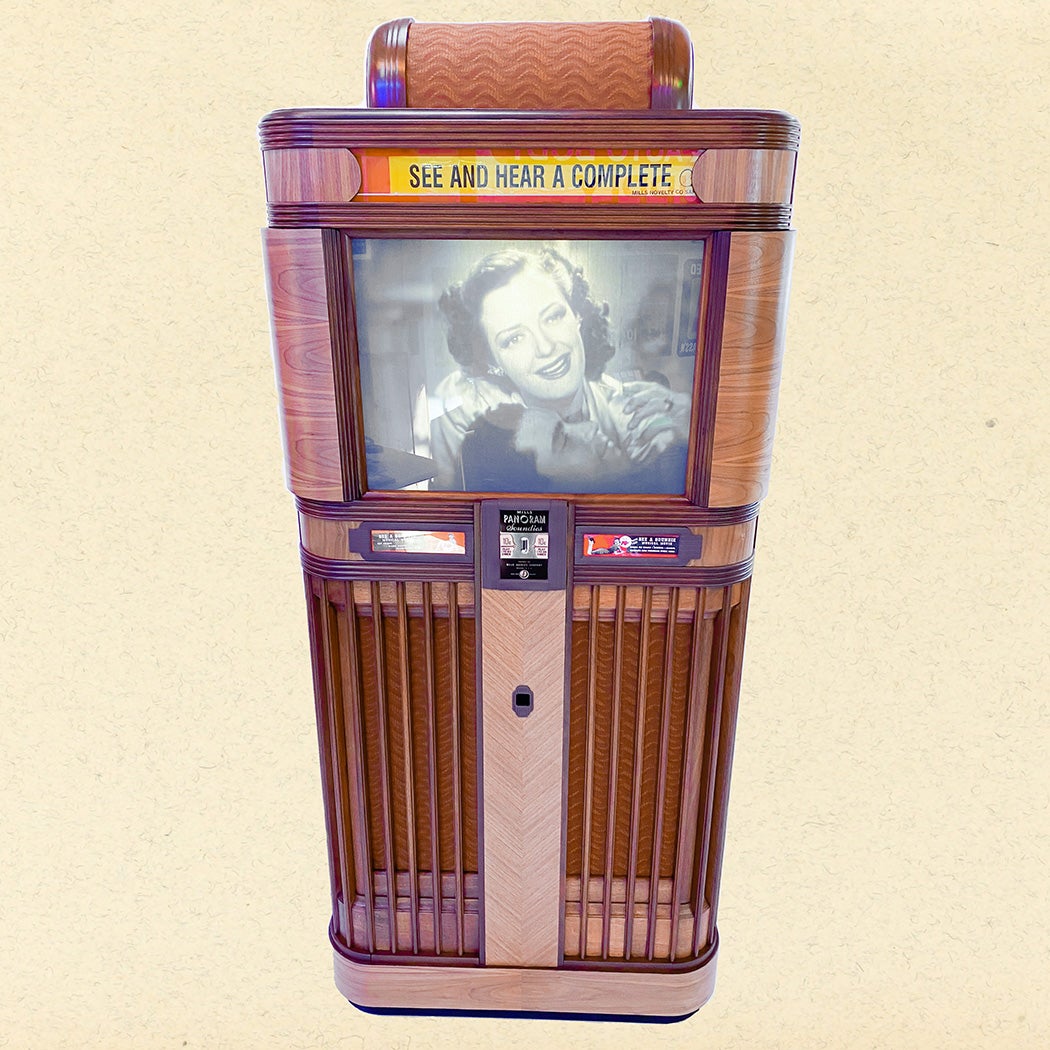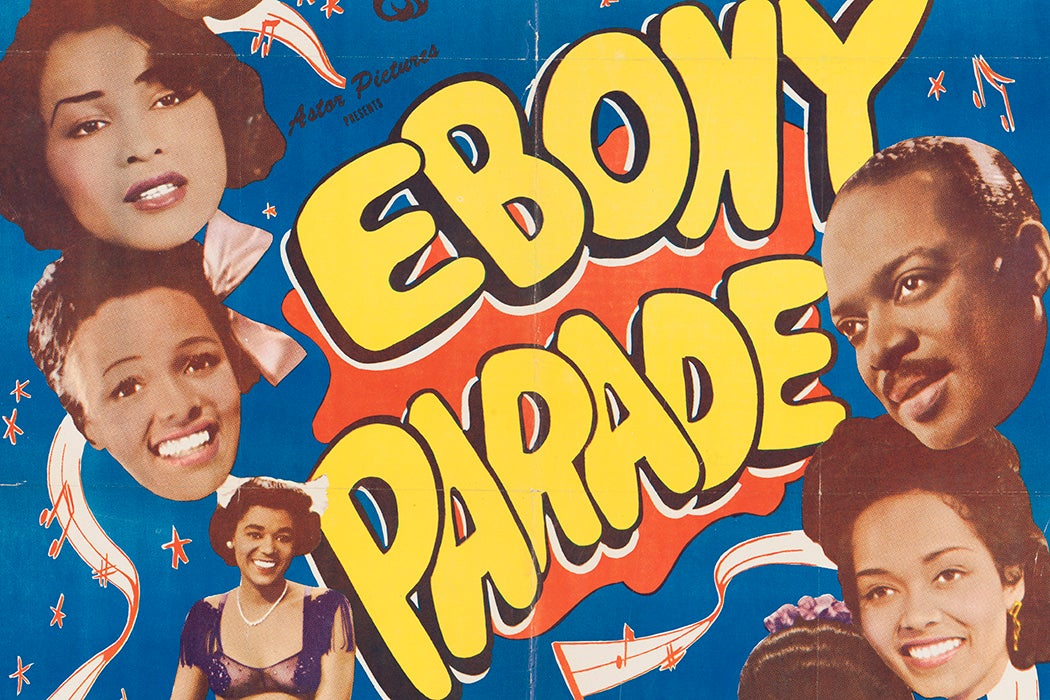From YouTube’s picking up the music video torch from MTV to Instagram reels and TikTok, we perhaps take for granted that we can pick up our phones and bathe in an infinite stream of bite-sized video entertainment. But one of the first technologies to experiment with putting music, sketch comedy, thirst traps, and political pump-up videos on film was produced during the 1940s.
The Mills Panoram machine debuted during a four-day event at the Roosevelt Hotel in Hollywood in September 1940, with five thousand people in attendance for the launch. Promoters claimed that “[m]ore than three years were spent to bring Panoram to its present state of perfection” and predicted that this new invention would revolutionize the entertainment landscape, according to film and media studies scholar Andrea Kelley.

The Panoram machine itself was simple enough. Measuring about six and a half feet tall by three feet wide, it was a large wooden cabinet with Art Deco trim. An embedded 27-inch screen was lit by revolving color cylinders when the 16-mm film projector set up inside wasn’t in action. People put dimes in the machine, up to twenty at a go, and watched a rotating set of eight short films set to music. There wasn’t an option to select the programming—if you popped a dime in, you picked up wherever the film was in the repeating reel.
The novelty and the relatively small size of the Panoram suggested that it could be placed nearly anywhere people tended to gather—bars, bus terminals, military bases, hotels, restaurants, and more. Automatic Age magazine reported that during the preview week, “Mills secured over $3,000,000, worth of orders for Panoram Movie Machines. Cash deposits of over $200,000 have been received covering these orders and securing territory allotments.”
The films made for the Panoram were called “Soundies.” Each was three minutes long, set to music, and light on plot—just bite-sized and effervescent enough to be worth that dime and produced cheaply and quickly enough to be sustainable. Soundies relied on formulaic elements and techniques in production: actors lip-synced to music on playback, and sets were generally basic (and often cheesy). Pretty girls and their stocking seams popped up all over the place.
Nonetheless, Soundies featured an impressive range of artists, from Spike Jones and Liberace to Louis Armstrong and Nat “King” Cole. Kelley reports that the Soundies Distributing Corporation, in a joint venture with Mills Novelty Co., produced 1,850 films between 1940 and 1947. Every week the distributor sent a new reel of eight films to machine owners.
Amy Herzog argues that it wasn’t specifically that Soundies brought music and film together that made them unique—after all, Hollywood was flush with film musicals at the time, so Soundies weren’t exactly breaking new creative ground.
“Novelty and topicality were the primary operatives of the Soundie,” she writes, “with vaudeville-style acts, burlesque numbers such as Sally Rand’s ‘The Bubble Dance,’ a flurry of World War I-related numbers, and comedy titles such as ‘Who Threw the Turtle in Mrs. Murphy’s Girdle?’”
Initial predictions had the Panoram turning the world of public entertainment on its head.
“Of course, this prediction proved erroneous,” notes Kelley. “[T]he jukebox remained the iconic symbol of American roadside amusement, and Panorams playing Soundies musical shorts quickly were rendered another obsolete media fad.”
Estimates hold that between three and five thousand Panoram machines dotted the American landscape at the height of their popularity, and ultimately, Soundies lived a short life before being largely undone by wartime supply pressures and the rise of television. But during their short period of production, they encompassed an impressive variety of content in a wide range of locations, leaving behind some very compelling and entertaining three-minute cultural artifacts (many of which can be found on the website of Susan Delson, author of Soundies and the Changing Image of Black Americans on Screen: One Dime at a Time).
Some Soundies took on the job of spreading wartime propaganda. Rosie the Riveter, from 1943, put a rivet gun in the hands of “a hefty, sexy blonde,” writes Kelley, and set the whole thing to harmonica music in an effort to show something attractive and inspiring to factory workers. As a reward for war-bond purchases, bond-rally attendees could watch patriotism and racism on parade together in “We’ll Slap the Japs Right into the Laps of the Nazis.” Ricardo Montalban slyly threatened to steal your girlfriend in He’s A Latin From Staten Island (1941), and folks could pound laughs and beer steins along with Spike Jones and his mustachioed City Slickers in Clink! Clink! Another Drink (1942).
But perhaps one of the greatest legacies of this brief film form was how it used and preserved a particular moment in Black music and dance, with a fullness not generally seen in the rest of American mass media (still, Black productions were listed in a separate section of the Panoram catalog). Some of this was structural, writes cinema and media studies scholar Ellen C. Scott.
“Soundies were not bound by the Hollywood Motion Picture Production Code, which banned miscegenation, limited drinking, and curtailed suggestive dialogue and lyrics,” Scott notes.
Weekly Newsletter
More than that, though, the Panoram provided a forum for Black performers and directors to be experimental; in a space where white actors were not there to serve as contrast, Black Soundies played with stereotypes and embraced surrealism—in one Louis Armstrong short, actors rub a sheet across the toe of a massive boot in a shoe-shine pastiche.
Drawing music, aesthetics, and performers from the Harlem nightclub scene, Soundies featured a range of content. A dime might get viewers a look at Paul White and Dorothy Dandridge dancing to zoot-suit jazz; swing by the International Sweethearts of Rhythm, a Black women’s big band; or Cab Calloway promising that “We the Cats Shall Hep Ya.”
Perhaps most importantly, comments Scott,
the Soundies showcased African Americans publicly exercising their right to the ‘pursuit of happiness’ by having fun on their own terms. This was a less impeccable yet dignified African American freedom, different from that which black uplift leaders championed, but one no less concerned with the dynamics and techniques of being free.
In 180 seconds of cinema, Scott writes, Soundies “transgressed Hollywood’s racial mythology with a broader dream of [B]lack life.”
Editor’s note: This article was amended to include a link to Susan Delson’s website.







